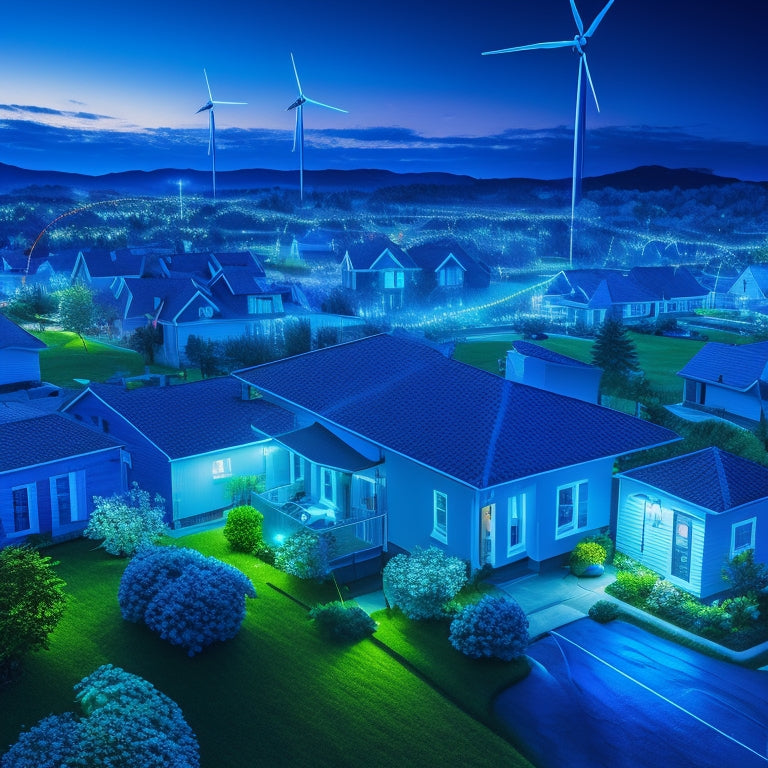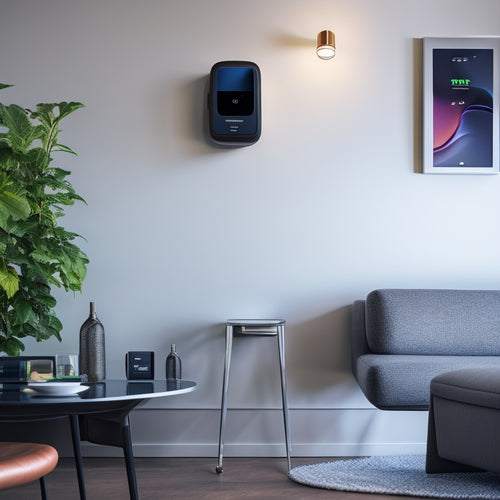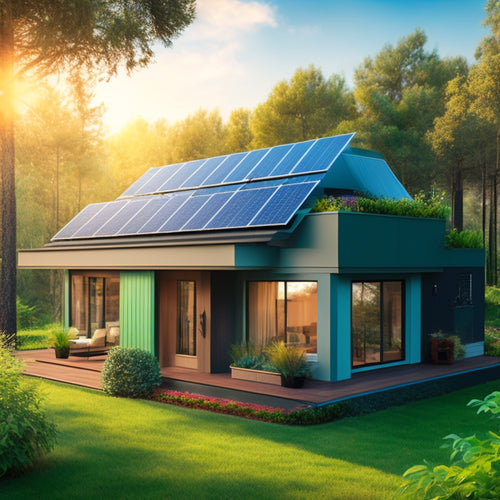
Simplify Neighborhood Energy Sharing: Your Step-by-Step Guide
Share
You're about to simplify neighborhood energy sharing by choosing the right platform, setting up energy monitoring, and understanding energy sharing options. Evaluate platforms for peer-to-peer trading and real-time monitoring, ensuring a seamless user experience. Install meters or smart devices for energy tracking, anonymizing consumer data and implementing end-to-end encryption. Next, investigate options like net metering, community solar programs, and peer-to-peer trading. Implementing these solutions will require maneuvering through complex regulatory structures, but the benefits include increased energy autonomy, community engagement, and renewable energy adoption. Now, delve deeper into the specifics of optimizing energy distribution.
Key Takeaways
- Evaluate platforms for features like peer-to-peer trading, real-time monitoring, and customization options to meet unique neighborhood needs.
- Install meters or smart devices for real-time energy consumption tracking, ensuring secure and anonymous data collection.
- Implement peer-to-peer energy trading to increase energy autonomy, enhance community engagement, and promote renewable energy adoption.
- Invest in smart grid infrastructure, demand response systems, and energy storage to optimize energy distribution and reduce reliance on the grid.
- Diversify renewable energy sources, such as solar-powered EV chargers, to ensure a consistent energy supply and reduce range anxiety.
Choosing the Right Platform
Immerse yourself in the world of neighborhood energy sharing by selecting a suitable platform that aligns with your community's needs.
Evaluate various platforms based on their features, such as peer-to-peer energy trading, real-time monitoring, and data analytics.
Consider the user experience, ensuring it's intuitive and accessible for all members of your community.
Look for platforms that offer customization options to tailor the system to your neighborhood's unique requirements.
Integrating solar-powered EV chargers can also promote eco-friendly energy use and contribute to a greener environment.
Assess the scalability and flexibility of the platform to accommodate future growth and changes.
Setting Up Energy Monitoring
Now that you've selected a suitable platform for your neighborhood energy sharing initiative, it's time to set up energy monitoring to track and manage energy distribution effectively. This involves installing meters or smart devices that can measure energy consumption in real-time. You'll need to guarantee that the data collected is secure and compliant with data privacy regulations.
| Monitoring Aspect | Description | Data Privacy Consideration |
|---|---|---|
| Energy Consumption | Track energy usage patterns and peak hours | Anonymize consumer data to prevent identification |
| Real-time Monitoring | Monitor energy distribution in real-time | Implement end-to-end encryption for data transmission |
| Historical Data | Store energy consumption data for analysis | Limit access to historical data to authorized personnel |
| Alert Systems | Set up alerts for energy consumption anomalies | Guarantee alerts are triggered only for authorized users |
| Data Analytics | Analyze energy consumption patterns to optimize distribution | Use aggregated data to maintain consumer anonymity |
Understanding Energy Sharing Options
Understanding Energy Sharing Options
Frequently, neighborhood energy sharing initiatives involve multiple energy sharing alternatives, each with its own benefits and challenges. As you investigate these alternatives, it's crucial to reflect on your community's unique needs and goals.
You'll want to assess how each alternative supports your community's commitment to renewable resources and encourages community engagement. Integrating solar-powered EV charging infrastructure, for instance, can mitigate range anxiety and enhance the overall reliability of the energy supply. Additionally, diversifying renewable energy sources can guarantee a consistent energy supply, reducing range anxiety for EV owners.
-
Net Metering: Allows individuals to generate their own renewable energy and export excess to the grid, offsetting their energy bills.
-
Community Solar Programs: Enables multiple individuals or organizations to share the benefits of a single solar array, reducing energy costs and promoting community engagement.
-
Microgrids: Local energy systems that can operate independently of the grid, providing resilience and energy security during outages.
- Peer-to-Peer Energy Trading: Enables individuals to buy and sell excess energy directly with their neighbors, cultivating community engagement and promoting renewable resources.
Implementing Peer-to-Peer Trading
By embracing peer-to-peer energy trading, your neighborhood can access a new level of community-driven energy sharing. This innovative approach allows individuals to buy and sell excess energy directly with one another, promoting a more localized and resilient energy system. To implement peer-to-peer trading, you'll need to overcome regulatory challenges and design user incentives that encourage participation.
| Benefits | Challenges |
|---|---|
| Increased energy autonomy | Complex regulatory structures |
| Reduced energy costs | Technical integration with existing grids |
| Enhanced community engagement | Ensuring fair pricing and trading practices |
| Promoting renewable energy adoption | Managing data privacy and security concerns |
Optimizing Energy Distribution
As you implement peer-to-peer energy trading in your neighborhood, optimizing energy distribution becomes vital to guarantee efficient and reliable energy flow. This involves ensuring that energy is distributed in a way that minimizes losses and maximizes energy efficiency.
To achieve this, focus on the following key areas:
-
Smart grid infrastructure: Invest in advanced technologies such as smart meters and IoT devices to monitor and manage energy distribution in real-time. By integrating solar energy and energy storage systems, as seen in solar-powered EV charging, households can reduce their reliance on the grid and enhance energy distribution.
-
Demand response management: Implement demand response systems that can adjust energy consumption based on real-time energy availability, reducing peak demand and strain on the grid. This is particularly important in rural areas where energy self-sufficiency is vital, as solar power reduces grid reliance and enhances energy independence.
-
Energy storage integration: Incorporate energy storage systems to store excess energy generated by households and release it when needed, reducing energy waste and improving overall efficiency.
- Predictive analytics: Employ data analytics and machine learning algorithms to predict energy demand and optimize energy distribution accordingly, ensuring that energy is delivered when and where it's needed most.
Frequently Asked Questions
How Do I Ensure Data Privacy in Neighborhood Energy Sharing Platforms?
To guarantee data privacy in neighborhood energy sharing platforms, you'll want to implement strong data encryption and obtain explicit user consent before collecting or sharing sensitive information, giving individuals control over their data and maintaining transparency throughout the process.
Can I Participate in Energy Sharing if I Rent My Home?
As a renter, you can participate in energy sharing, but you'll need to discuss renter rights with your landlord, ensuring you're allowed to install necessary equipment. You'll earn energy credits, redeemable for bill reductions or cash, making it a lucrative opportunity for freedom-seeking individuals like you.
Are There Any Government Incentives for Neighborhood Energy Sharing?
You'll be intrigued to know that 75% of Americans support renewable energy incentives! As you investigate neighborhood energy sharing, you'll uncover government programs offering energy credits, which you can utilize to offset costs, promoting a freer, more sustainable energy economy.
How Do I Handle Disputes or Issues With My Energy Sharing Neighbors?
When handling disputes with energy sharing neighbors, you'll want to establish clear conflict resolution processes and communication strategies from the start, ensuring open dialogue and swift issue resolution, so you can maintain harmony and freedom in your shared energy community.
Can I Sell Excess Energy Back to the Traditional Grid?
You're likely aware that in 2020, the US grid received 2.2 billion kWh from small-scale solar installations. Now, you're wondering if you can sell excess energy back to the traditional grid. Yes, you can, through energy buyback programs, but you'll need to meet grid connection requirements, ensuring a safe and efficient exchange.
Related Posts
-

7 Best EV Battery Health Trackers for Homeowners
You can maximize your electric vehicle's performance and lifespan by leveraging advanced battery health trackers that...
-

3 Green HVAC Filters for Solar-Powered Homes
When outfitting your solar-powered home with an HVAC system, you'll want to choose filters that align with your commi...
-

Why Grow Up? Vertical Gardens Transform Urban Living
As you change your urban living space, you're not just growing up - you're bringing nature back into the heart of the...


